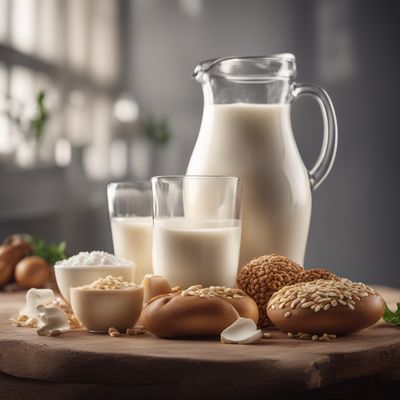
Ingredient
Dromedary milk
The Versatile Dromedary Milk
Dromedary milk is a creamy and slightly sweet milk derived from dromedary camels. It has a pale yellow color and a smooth, velvety texture. The milk is rich in vitamins, minerals, and proteins, making it a valuable source of nutrition in regions where other dairy products are scarce. Dromedary milk is traditionally consumed fresh or used to make various dairy products like cheese and yogurt.
Origins and history
Dromedary milk has a rich cultural and historical significance, particularly in the Middle East, North Africa, and parts of Asia. It has been consumed by nomadic communities for centuries due to its ability to provide sustenance in harsh desert environments. Dromedary milk is also considered a symbol of hospitality and is often offered to guests as a sign of respect and generosity.
Nutritional information
Dromedary milk is a nutritional powerhouse, containing high levels of vitamins A, B, and C, as well as essential minerals like calcium, potassium, and iron. It is also rich in proteins and healthy fats. Additionally, dromedary milk is lower in lactose compared to cow's milk, making it a suitable option for individuals with lactose intolerance.
Allergens
Dromedary milk may cause allergic reactions in individuals who are sensitive to camel milk proteins. It is also not recommended for individuals with lactose intolerance, as it still contains a small amount of lactose.
How to select
When selecting dromedary milk, look for products that are made from 100% pure camel milk without any additives or preservatives. Opt for pasteurized milk for safety reasons. Check the label for the country of origin and choose products that are sourced from reputable producers.
Storage recommendations
To maintain the freshness and quality of dromedary milk, it should be refrigerated at temperatures below 4°C (39°F). It is important to consume the milk within a few days of opening to prevent spoilage. If freezing is necessary, it is recommended to freeze the milk in small portions to maintain its texture and flavor.
How to produce
Dromedary camels are primarily found in arid regions of the Middle East, North Africa, and parts of Asia. They are well-adapted to desert environments and can withstand extreme temperatures and limited water resources. Raising dromedary camels for milk production requires specialized knowledge and resources, making it more suitable for commercial farms rather than home production.
Preparation tips
Dromedary milk can be consumed fresh as a beverage or used as a substitute for cow's milk in various recipes. It can be used to make cheese, yogurt, ice cream, and other dairy-based products. Additionally, dromedary milk can be incorporated into both sweet and savory dishes, adding a unique flavor and richness to the final creation.
Culinary uses
Dromedary milk is commonly used in Middle Eastern and North African cuisines. It is a key ingredient in traditional dishes like camel milk tea, camel milk pudding, and camel milk ice cream. It is also gaining popularity in Western countries as a dairy alternative for individuals with lactose intolerance or those seeking a unique flavor experience.
Availability
Dromedary milk is commonly available in countries like Saudi Arabia, United Arab Emirates, Egypt, Somalia, and India. It can be found in local markets, specialty stores, and online retailers that cater to Middle Eastern or African products.
More ingredients from this category

Human milk
Nature's Nourishment

Milk from other milk producer animals
The Versatile Dairy Elixir

Elk milk
The Nutritional Elixir: Unveiling the Wonders of Elk Milk

Bactrian camel milk
"The Golden Elixir: Unveiling the Richness of Bactrian Camel Milk"

Reindeer milk
Arctic Elixir: Unveiling the Secrets of Reindeer Milk